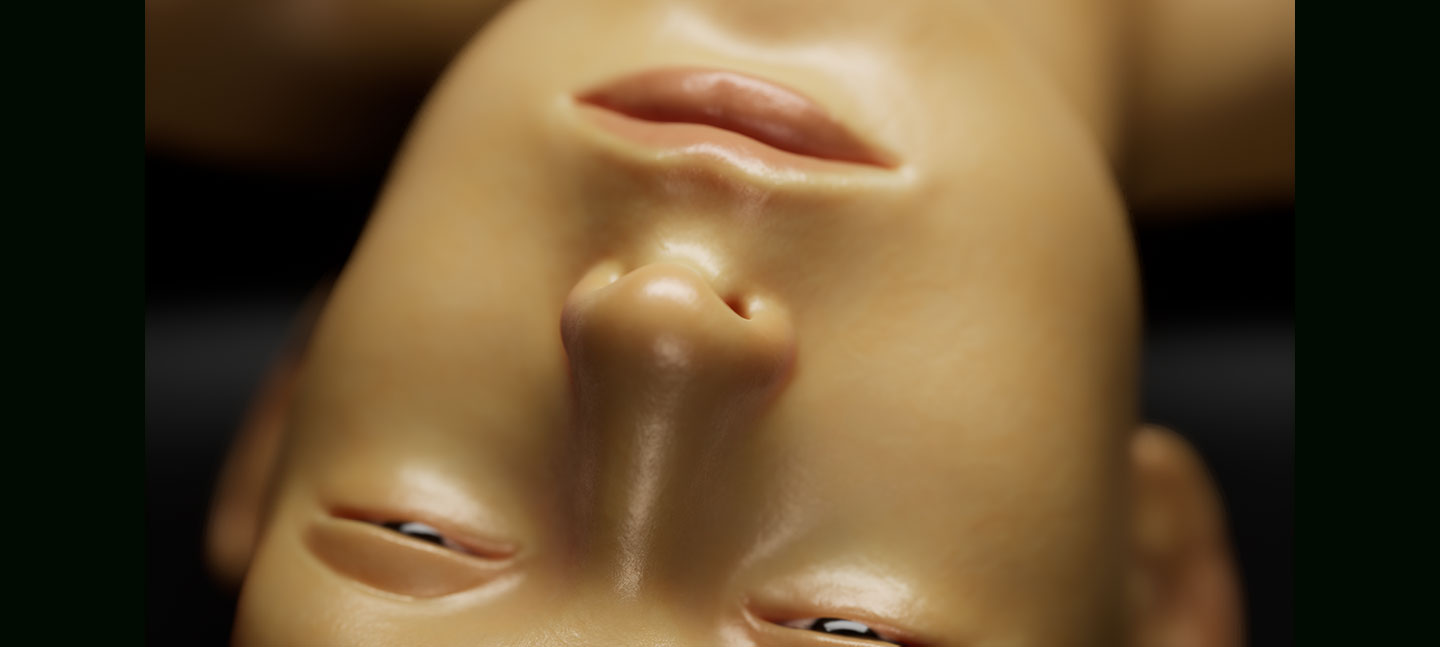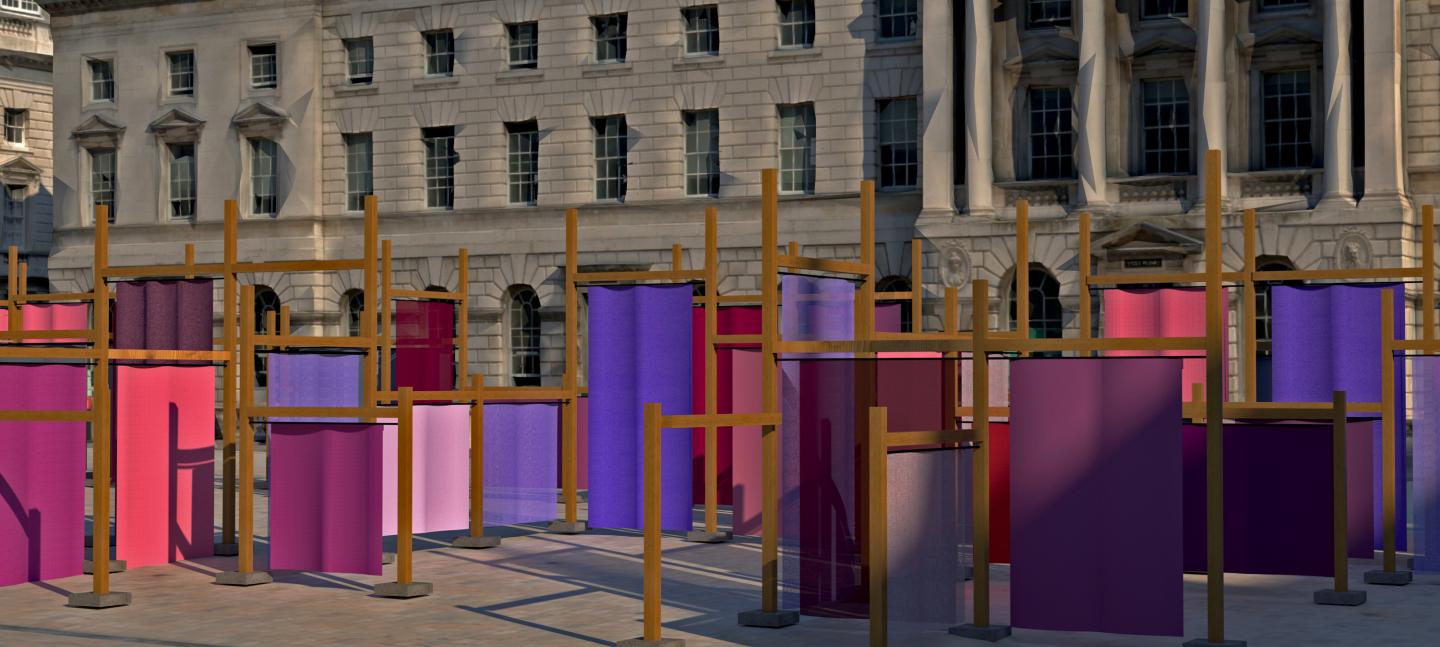The Biennale will take place at Somerset House from 1-25 June. The theme of this year’s Biennale, ‘The Global Game: Remapping Collaborations,’ goes beyond borders and territories to enact new forms of international cooperation and participation through the medium of design. This year’s Artistic Director is Nieuwe Instituut, the Dutch national museum and institute for architecture, design and digital culture, led by General Director, Aric Chen.
Running alongside London Design Biennale, the EUREKA exhibition will share design-led innovation from leading research centres. It will spotlight university research departments, demonstrating cross-disciplinary invention and creativity changing the world of tomorrow.
▪ A press view for London Design Biennale will take place on the morning 1 June, 2023, at Somerset House from 9:30am-1:00pm. RSVP essential to ldbpress@brunswickgroup.com
▪ Media accreditation for London Design Biennale from 2 June is now open: https://tinyurl.com/LDB23-press-accreditation
▪ Please find a selection of press images here.
▪ For more information regarding exhibitors, additional imagery or to arrange an interview please contact LDBpress@brunswickgroup.com
(Images L-R: Malta; Abu Dhabi; Turkey)
London Design Biennale exhibitor list
Abu Dhabi
The traditional weaving technique of Al-Sadu will be at the centre of the Abu Dhabi pavilion. Practiced by Bedouin women in the United Arab Emirates, using the wool of sheep, camels and goats, this craft is architecturally fundamental to the building of traditional tent structures and was inscribed onto the UNESCO List of Intangible Cultural Heritage in Need of Urgent Safeguarding in 2011.
Ai-Da Robot
Ai-Da Robot will make history by showing her unique ability to design objects. This is the first time a humanoid robot has ever achieved this as a designer. As the world’s first humanoid robot artist, new AI innovation has enabled her to develop her creativity in ways that prompt questions about humanity, the nature of creativity, what we want from AI, and what we might get.
Austria
A loaf or slice of bread may seem simple, but there is a curious complexity to the matter of bread. From geopolitical contexts to microbiological processes to multi-sensory experiences, bread and bread making can open up a whole new universe and pathway for transformative design practices.
Automorph Network
Creative Differences is a collaboration between scientists and designers, working together on the concept of self-shaping matter. While common human approaches seek to eliminate difference, inhomogeneity is nature’s generative mechanism of variety and harmony. Collaboration via differences, in matter and beyond, paves new paths for ideas and developments that will shape our future.
Beatie Wolfe
‘ImPRINTING’ takes a creative and playful look at the nature of neurology and reveals via a sonic portrait how we can gain a greater understanding of ourselves and of one another.
Bidibidi
The Bidi Bidi Music & Arts Centre in northern Uganda’s Bidi Bidi Refugee Settlement aims to reframe the narrative around what it means to be a refugee. Currently under construction, the new building is the result of an interdisciplinary collaborative project led by to.org, a platform operating in venture capital, philanthropy and the creative space, in collaboration with the Bidi Bidi community, international architecture practice Hassell, Kampala design studio LocalWorks, and global engineers Arup.
Care Pavilion
The Care Pavilion offers fertile ground for carefully considering the concept of ‘care’ through multiple dimensions and perspectives. The installation is a living collection of attempts to re-imagine the politics and ethics of care by interdisciplinary designers, activists, scholars, healers and cultural practitioners from the Global South and Global North.
Chatham House – The Future for Beginners
On a small peninsula, five towns are preparing to make a comeback. Unjustly forgotten by the world, the community is about to launch a major cultural festival showcasing the region’s unique arts, music, food and sporting prowess. This is going to revitalise the area and make these towns internationally famous.
Chile
Reflecting on the extractivist processes of the logging industry in Chile, ‘Materia Prestada’ is a sensorial installation highlighting novel ways of working with wood cellulose as a bio medium. Four handmade textile pieces made with natural fibres and cellulose sheets will gradually degrade during the exhibition to reveal hidden layers of information for visitors to discover.
Democratic Republic of the Congo
The pavilion of the Democratic Republic of the Congo reimagines the country’s national museum as a vivid virtual world, offering visitors a futuristic digital experience which brings central Africa’s diverse and dynamic cultures to life.
Denmark & Switzerland
‘Blue Nomad’ is a self-sufficient solar floating habitat showcasing a fossil-free future for living and travelling on the ocean. To address climate change, rising sea levels and contemporary nomadism, ‘Blue Nomad’ provides a small, comfortable, and permanent living space that relies purely on solar power.
Dubai
‘And Beyond’ transports visitors from Dubai's ancient camel caravans to the futuristic Emirates Mars Mission Hope Probe, exploring the power of human connection through immersive design and storytelling.
Humanitarian pavilion by Shigeru Ban
Transforming any space into a shelter for privacy, dignity and hope, ‘Paper Sanctuary’ is a collaboration between architect Shigeru Ban, Ukrainian-born poet, novelist and literary translator Svetlana Lavochkina, and Ukrainian composer Valentin Silvestrov. Ban’s Paper Partition System – used to provide refugees with privacy in evacuation facilities in Poland, Slovakia, France and Ukraine – is exhibited with poems and music to draw attention to the need for recovery housing to support refugees in Poland and Ukraine.
India
The Indian pavilion is a multi-sensory evocation of the essence of a contemporary Indian city chowk – an open market at the junction of streets – through the visual metaphor of a charpai – a traditional woven daybed found across India. The charpai is a design icon that transcends time, and its weave is representative of Indian craft. Its versatility expresses “Indianness” with its plurality of use. In essence, the charpai is a micro chowk in itself - a place for conversations and collaborations.
Inner Peace
The Nelson Staircase, an exquisite replica of the Navy Stair that suffered bomb damage in WWII, stands as a symbol of resilience and the significance of peace. The ‘Inner peace’ live performance represents a convergence of ‘Music-mind-textile’, seeking to inspire equity, diversity, and inclusion through an immersive multi-sensory performance.
Italy
An exhibition that highlights the processes of cooperation, reuse of artefacts, and interpretations of production cycles by reflecting an object’s end of life. The project showcases the opportunities to put resources and projects that started their life in Italy back into circulation in very different geographical locations.
Japan
‘The future is rural’ is about people – artists, designers, visionaries and entrepreneurs – who are deeply invested in re-activating rural Japan. This installation brings them together to tackle issues such as depopulation and the ageing society, resulting in a multi-media work inspired by interactions with local people, local traditions and the cultural heritage of Japan.
Malta
Malta will create a large-scale ‘village-square’ installation that merges traditional city planning with the Phoenician-Maltese tradition of fabric production and dyeing of the multiple colours of Phoenician purple. The installation uses wood, recycled stone and organic fabric that is certified eco-friendly for its main components. These create a ‘street-like’ layout that enables the audience to meet and collaborate while interacting directly with the installation.
mudac
The Museum of Contemporary Design and Applied Arts in Lausanne, Switzerland will present installation ‘G80’ – a contemporary reinterpretation of R. Buckminster Fuller's “World Game” which was a strategy simulation tool inspired by war games, which aimed for "an equitable distribution of resources" on a planetary scale.
Netherlands
Viewing orientation itself as something that is constantly shifting, fragments of the Dutch installation will be distributed throughout Somerset House. Each fragment offers itself up to other pavilions and communal spaces as potential anchor points dispersed throughout the building.
Nigeria
‘Natural Synthesis’ invites visitors into a classic Nigerian courtyard scene to contemplate the nature of collaboration and conflict. This tactile pavilion presents an innovative collection of arthropodal carbon fibre lounge chairs, exploring an intercontinental exchange between two great natural systems: the Amazon and the Sahara.
Poland
In times of need, urgency and uncertainty begin to enter the creative process, while architecture and design mix with social activism. Those are the days of change, adaptation and hope – new sources of creativity. The exhibition explores how unexpected everyday objects such as windows emerge from the world crisis, remapping collaborations.
Romania
Romania will bring visitors closer to nature and encourage them to contemplate humanity’s legacy on our planet. The installation offers a multi-faceted area for relaxation and discussion where visitors can meditate, exchange ideas, play, listen to plant sounds to encourage communication and collaboration for innovation.
Saudi Arabia
‘Woven’ is a collaborative installation where the future is interwoven with the fabric of humanity. Originating in the delicate hands of powerful women in the Arabian desert practising the artisanship of Al Sadu – the ‘Saddayah’ weaves humble materials into textiles.
Serbia
This pavilion looks at the etymology of the concept of design. How do you define design, but not create limitations or directions? Project ‘134/Sacred Geometry’ is inspired by the point at which theological and technological design collaborate.
South Korea
Can we live harmoniously and sustainably in this age of globalisation? Design from past traditions can help to bridge the gap between humans, nature and the modern and future world by following the principles of balance, coexistence and collaboration. Visitors will be transported through time and distance to the Virtuous Garden via the modern means of virtual and mixed reality.
Spain & Peru
Spain and Peru are collaborating for an audio and visual installation that showcases the cultural heritage shared by two countries through a percussion instrument: the cajón. Without using words, this collaborative project that requires collaboration to join in, invites visitors to delve into a percussion dialogue to discover this shared cultural symbol.
Taiwan
Due to its unique geographical location and technological capabilities, Taiwan has become an important world trade hub and collaboration partner. For its presentation, it showcases collaborations the territory has across industry, trade, natural resources and economy.
The European Union Delegation to the United Kingdom
‘The New European Bauhaus’ is a movement that facilitates and steers the transformation of European societies along three inseparable values: sustainability, aesthetics and inclusion.
Turkey
‘Openwork’ is a performative space and a theatrical exhibition of transitions. Shaped around the metaphors of a ‘gate’ and ‘liminality’, it plays with the meaning of these concepts, which have been the representations of power, setting borders and social hierarchy throughout world history.
Ukraine
The Ukrainian Pavilion will have two spaces: inside and outside a transparent structure. The space inside the construction symbolises Ukraine's industrial, natural resource, and creative richness. The projects outside the fragile structure tell stories about new design collaborations in times of crisis for Ukraine and the vital role of design in creating new progressive connections.
USA
Silicon Valley is designing the world’s future landscape. As flat as our screens may be, virtual universes are quickly replacing the depth of the natural universe. ‘A Species Between Worlds’ reveals the encroaching digital landscape, our attachments to it, and the uncertain fate of our nature.
EUREKA exhibitor list
Canterbury Christ Church University
Canterbury Christ Church University presents Arcade Britannia which celebrates the central role of amusement arcades in British culture as spaces of social, economic, and technological change. The centrepiece of the project is an interactive digital recreation of a late 1980s seaside arcade enhanced by stories of the people who worked and played in these spaces.
Centre for Natural Material Innovation, Cambridge University
Ephemeral: Natural flexible living, envisages a future in which the home transforms with its occupants through natural materials and flexible systems. Using sustainable building materials, such as timber, and new digital and natural technologies, Ephemeral investigates ‘soft flexibility’, where residents can customise their space organically.
The Design Age Institute at the Royal College of Art
Designing for our Future Selves, curated together with the Design Museum, explores ten projects on how design is reimagining the way society can support everyone to age with greater agency and joy.
The Glasgow School of Art
Undercurrents: Art and Ocean in Africa and the Pacific presents an interdisciplinary and international research project showcasing the creative outputs of eight community-based art projects that surface cultural and emotional connections with the ocean in Ghana, South Africa, Solomon Islands, Vanuatu and Papua New Guinea.
Kings College London
In Seeking Connection, researchers confront the meaningful connections that we have with ourselves, our communities and planet through a journey of discovery. With the use of digital design and data, King’s College London’s immersive experience of light and sound, Seeking Connection, deals with topics of mental health, vulnerability and loneliness, identity, autonomy, and privacy.
Kingston University
Responding to British colonialism and industrialisation, Kingston University have produced THE GARDEN, a digital recreation of the carpet loom. It explores how this technology drew together materials from across British Colonies to create idealised images of land or terrain.
Lab4Living, Sheffield Hallam University
Re-imagining the 100-year life uses creative practices to explore, identify and navigate the multiple transitions that ageing inevitably brings in an increasingly challenging and changing world.
The National Innovation Centre for Ageing (NICA)
Flip the Script rethinks what growing older means, inviting visitors to shape how you age through their interactive installation.
The University of Strathclyde
Guddle: designing futures showcases innovative ways to design and produce new outcomes for the city of Glasgow, with contributions from both staff and students. All co-designed and locally developed, the interventions present new methods, products, processes, services, systems, technologies, and ways of working and living in a post-industrial city such as Glasgow.
University of the Arts London
The University of the Arts London demonstrates what design can do when social purpose is at its core and how creativity has a leading role in solving world’s issues. Their research and innovation imagines a better world and how to bring it to fruition, celebrating research from across UAL’s 5 Colleges.
Notes to editors Contact For further information please contact: Brunswick Arts | Charlotte Sidwell, Tom Smeeton and Sidje N’Choh: +44 7467 650396 LDBpress@brunswickgroup.com
About London Design Biennale
Established in 2016 by Sir John Sorrell CBE and Ben Evans CBE, London Design Biennale promotes international collaboration and the global role of design. Since its inception the Biennale welcomes the world’s most exciting and ambitious designers, innovators and cultural bodies to the capital.
The fourth edition of London Design Biennale will take place from 1 to 25 June 2023, artistically directed by the Nieuwe Instituut—the Dutch national museum and institute for architecture, design and digital culture. Taking over the entirety of Somerset House, including the Edmond J. Safra Fountain Court and River Terrace, participants from across the globe will be invited to imagine and enact new forms of international cooperation and participation—including with each other—through the medium of design.
London Design Biennale's International Advisory Committee and Jury includes: Paola Antonelli, Victoria Broackes, Aric Chen, Es Devlin OBE, Nipa Doshi, Ben Evans CBE, Marva Griffin Willshire, Suhair Khan, James Lingwood MBE, Prof. Jeremy Myerson, Tosin Oshinowo, Jonathan Reekie CBE, Rashid and Ahmed bin Shabib, Sir John Sorrell CBE, Dr. Christopher Turner.
londondesignbiennale.com
About EUREKA
EUREKA is a showcase of design-led innovation changing our world from leading research centres.
EUREKA will spotlight the ground-breaking creative thinking taking place inside the UK’s university research departments for our society and the economy, while examining the role of institutions in nurturing the next generation of problem solvers.
Together with London Design Biennale, the exhibition will come to Somerset House in June to address ideas around sustainability, health, aging and community cohesion that are in an incubator to start-up phase.
eurekabydesign.com
About Nieuwe Instituut
The Nieuwe Instituut is the Netherlands’ national museum and institute for architecture, design and digital culture. Based in Rotterdam, a global centre for design innovation, the institute’s mission is to embrace the power and potential of new thinking, exploring past, present and future ideas in order to imagine, test and enact a better tomorrow. Encouraging visitors of all ages to question, rethink and contribute, the institute’s exhibitions, public programmes, research, and wide-reaching national and international initiatives provide a testing ground for collaboration with leading designers, thinkers and diverse audiences, critically addressing the urgent questions of our times.
In addition to housing the National Collection for Dutch Architecture and Urban Planning, the institute manages the 1933 Sonneveld House, a leading example of Dutch Functionalist architecture, as part of its campus in Rotterdam’s Museumpark.
In 2022, the Nieuwe Instituut became the world’s first Zoöp, a ground-breaking model through which all areas of the museum’s operations and programming are informed by its impact and benefit to other forms of life.
Ecological management and creating a high level of biodiversity are also the starting points of the New Garden. The institute also serves as commissioner of the Dutch pavilion at the Biennale Architettura in Venice and, in 2023, will act as the Artistic Director of the fourth edition of London Design Biennale, where it set the theme of this edition and initiated The Global Game, a web-based collaboration game developed by Play the City. hetnieuweinstituut.nl
About Somerset House
As the home of cultural innovators, Somerset House is a site of origination, with a cultural programme offering alternative perspectives on the biggest issues of our time. We are a place of joy and discovery, where everyone is invited to Step Inside and Think Outside.
From our historic site in the heart of London, we work globally across art, creativity, business, and non-profit, nurturing new talent, methods and technologies. Our resident community of creative enterprises, arts organisations, artists and makers, makes us a centre of ideas, with most of our programme home-grown.
We sit at the meeting point of artistic and social innovation, bringing worlds and minds together to create surprising and often magical results. Our spirit of constant curiosity and counter perspective is integral to our history and key to our future. somersethouse.org.uk




